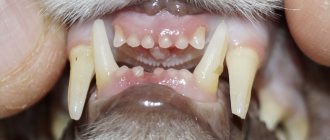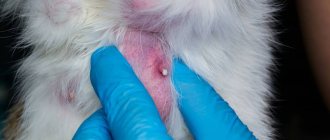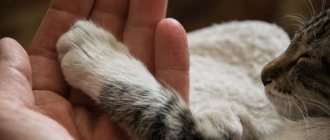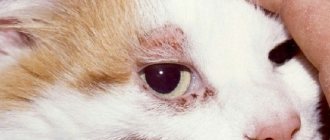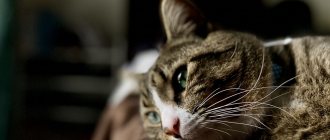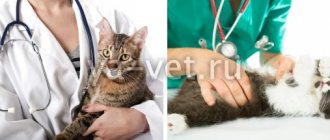Inflammation processes in the oral cavity in cats negatively affect the entire functioning of the body. The process of chewing and further digestion of food deteriorates significantly, the body's defenses are weakened, and the load on the heart muscle increases.
A responsible, attentive cat owner should be aware of the number of teeth in the pet's mouth, know how to properly care for the pet's oral cavity, and also know when to seek advice from a veterinarian.
The cat's dental system is represented by the following types of teeth: 12 incisors, 4 canines and 14 premolars. The period of replacement of milk teeth with permanent teeth ends on average by the age of eight months. It is important to note that if, when the cat reaches 12 months of age, it has not had a complete replacement of its teeth, the animal will suffer. Congenital anomaly of dental development - oligodontia, has a genetic predisposition, transmitted through generations. Such animals are discarded during breed selection and breeding.
Causes of dental disease in cats
Dental diseases in veterinary medicine have their own classification and vary in severity. There are a number of factors that negatively affect the normal physiological development of teeth in a cat. The main ones are:
- incorrect position of a row of teeth;
- dietary disorders;
- infectious diseases;
- lack of timely veterinary care for injuries and other pathologies developing in the cat’s oral cavity;
- changes in the qualitative composition of saliva and the ratio of beneficial and pathogenic microflora in the animal’s mouth (as a result, there is a risk of developing dangerous diseases);
- factor of genetic heredity (a number of cat breeds have been identified that have a predisposition to dental diseases).
Taking into account all these main factors, it is recommended to carefully carry out hygienic procedures for the cat’s oral cavity and monitor the diet so that non-soft food predominates in it. Cats with a genetic predisposition need to undergo preventive examinations by veterinarians once every six months.
Find out also about stomatitis in cats >>>
Development of plaque and tartar
Nature gave cats white teeth. All kinds of shades of gray and yellow indicate a lack or improper care.
Plaque deposition occurs as follows. Pathogenic microorganisms live and multiply in the film of saliva that covers the teeth. Over time, there are more of them, the film thickens and turns into plaque. Most often it is located on the canines and back teeth. Over time, it turns into stone, with certain factors accelerating its formation. Among them:
- the diet contains only soft food;
- incorrect position of teeth;
- violation of salt metabolism.
If plaque is not removed, it can lead to various pathologies - teeth rot, teeth fall out, and problems with gums arise. During self-examination, it is difficult to completely detect plaque - only the areas that are above the gum are visible.
You can remove plaque with a special toothbrush, but not every pet will like this procedure and will tolerate it calmly. There are also special additives for drinking water that prevent tartar deposits.
Symptoms of toothache in cats
The cause of dental disease in cats is a large number of external environmental factors and internal pathologies. Any attentive owner can notice the appearance of characteristic signs of problems in a pet’s teeth or gums. To do this, it is not necessary to look into the animal’s mouth. The main symptoms of the development of diseases in the oral cavity are:
- pronounced rubbing of the muzzle against furniture and things, while the animal does not show pleasure;
- the appearance of a repulsive odor from the mouth;
- gum hyperemia;
- discoloration of tooth enamel;
- display of aggression when the owner tries to look into the mouth;
- refusal to eat due to pain;
- increased secretion of salivary fluid.
How to tell if your cat has toothache
Toothache for cats is not only an unpleasant sensation, but also a risk factor for the occurrence of other, more serious diseases of organs and body systems. Therefore, it is very important to monitor the oral health of your beloved pets.
It is not difficult to identify toothache in an animal. Firstly, a cat with bad teeth eats slowly, carefully and with extreme caution. In addition, the unfortunate animal may accidentally drop pieces of food from its mouth. In this state, the cat is not able to eat much. Secondly, due to severe pain, the cat may refuse to eat at all. Thirdly, if the teeth itch, the kitten may rub its muzzle against chairs or other hard furniture, making plaintive sounds.
The most common dental diseases in cats
Pathological conditions of the cat's oral cavity are manifested by inflammatory processes in the gums, and also affect the tooth itself. The causes may be tooth decay, for example due to caries, as well as trauma to the muzzle and jaws. The most commonly diagnosed diseases of the teeth and gums are:
- Tartar . Tartar is a layer with a porous structure. Pathology occurs when there are disturbances in feeding and untimely cleaning of plaque. As a rule, the stone forms in the base area, affecting the root and gum structures. The started process is characterized by complete coverage of the tooth body with a dense layer. resulting from untimely removal of dental plaque. Characteristic signs of the disease are a repulsive odor from the mouth, bleeding and itching in the gum area. The animal tries to make less effort when chewing solid particles of food due to the feeling of discomfort.
- Plaque. A grayish-yellow film formed under the influence of a large number of bacterial microorganisms in the mouth, food residues and salivary fluid. At the first stages, it is not noticeable to the owner and is determined exclusively by a veterinarian using special diagnostic methods. With the development of the pathological process, the film thickens, plaque covers the entire area of the tooth surface and, in the absence of hygienic procedures, turns into tartar. The formation of plaque on a cat’s teeth is determined by both genetic predisposition and an incorrect approach to feeding.
- Caries . The process of decay, as a result of which parts of the tooth, and especially the enamel, are destroyed, forming a through cavity. There are many reasons for the appearance of pathology, but the main ones are a lack of mineral nutrients due to an unbalanced diet or disturbances in metabolic processes in the body. Various mechanical injuries with the formation of a wound surface and infection lead to the penetration of pathogenic bacteria and the development of putrefactive processes in the core of the tooth.
- Odontogenic osteomyelitis . An inflammatory disease that damages the tooth, the soft tissue around it, the alveoli and even the bone marrow. The main cause of dental osteomyelitis in cats is advanced pulpitis, a complication of purulent processes (caries or periodontitis). Odontogenic osteomyelitis is characterized by hyperemia of the gums, pain when chewing food, edema and swelling of the muzzle. Often neglected odontogenic osteomyelitis is accompanied by the development of an abscess, with the further formation of fistulas through which purulent exudate can be released, and regional lymph nodes enlarge.
- Periodontitis . A common disease often diagnosed in the clinical practice of veterinarians. With the development of periodontitis, the upper part of the tooth root is affected. It is diagnosed in cats after two years of age and often becomes chronic. The development of periodontitis occurs when plaque, caries, removal of molars, blows to the crown of the tooth, foreign objects stuck in the gums and not removed in a timely manner are not removed.
- Gingivitis . An inflammatory process of a chronic nature that develops on the mucous membrane of the gums. The primary manifestations of the disease appear as a yellowish coating on the hard part of the tooth. This happens when food particles get stuck between the teeth. The tissue structures begin to become inflamed, hyperemic, bleeding and ulcerative lesions appear on the gums.
- Tooth resorption . Pathology leading to gradual tooth loss and degenerative processes in the tissue structures around them. In veterinary sources, resorption is called odontoblastic resorptive lesion, developing from the gum area, destroying tooth tissue and replacing it with bone tissue. As a rule, premolars are affected, and then other teeth may be damaged. Resorption is not a contagious pathology, but when a tooth is lost, an infection of bacterial or fungal etiology can occur, which leads to purulent tissue lesions.
Prevention and care
To prevent the occurrence of dental pathologies, veterinarians recommend starting to monitor your cat’s oral cavity from an early age. Kittens should eat well; their diet must include complete protein in the form of white meat, cottage cheese, eggs, and dairy products. Specialists at the Zoovet veterinary clinic recommend periodically giving your pet special dietary supplements that replenish the deficiency of useful micro- and macroelements and vitamins.
Don't forget about keeping your mouth clean. To prevent the development of pathologies such as caries, gingivitis, periodontitis, and tartar, it is recommended to brush your pet’s teeth with a special brush and toothpaste 1-2 times a week. The animal removes plaque on its own using roughage. But hard foods should not predominate in the diet, because they injure the gums, which leads to dental diseases.
Treatment of dental disease in cats
As a result of what has become the leading cause of dental disease in cats, the veterinarian selects individual treatment suitable exclusively for a particular animal.
If the cause of a cat’s dental problems is tartar, therapy is based on its complete removal. The optimal method of cleaning damaged tissue is selected, based on the severity and neglect of the degenerative process.
In the first stages of tartar formation, it is possible to eliminate it with the help of special gels or ointments. Advanced cases of plaque and tartar require anesthesia and removal of growths using ultrasonic equipment or a chisel.
Treatment for spotty and superficial caries involves treating the affected tooth with a special solution of sodium fluoride or silver nitrate. It is quite problematic to give a pet a full-fledged filling, so in the vast majority of cases of advanced caries, they are treated by removing the diseased tooth.
The initial stages of osteomyelitis can be treated with broad-spectrum antibiotics, sulfonamide medications and immunomodulatory drugs. More advanced cases of the development of dental osteomyelitis include surgical intervention under local or general anesthesia, opening of the resulting fistula, removal of purulent contents from the cavity and treatment with special antibacterial solutions.
Periodontitis can be treated by spraying the cat's mouth with disinfectant solutions. In the affected area, the tooth is treated with iodine-glycerin or a 5% alum solution. Treatment for gingivitis depends directly on the stage of neglect of the pathological process. Sick animals must undergo daily cleaning and treat the affected gums with medicinal ointments. Advanced cases require antimicrobial and hormonal therapy.
What treatment is prescribed?
How to treat with drugs?
A veterinarian treats a cat’s sick and yellow teeth. Conservative therapy is carried out at the initial stages of the disease, its main goals are:
- eliminate inflammation;
- destroy the infection;
- relieve pain;
- prevent the spread of the pathological process.
Effective treatment involves the use of the following groups of drugs:
In some situations, prescribing antibacterial therapy to an animal is justified.
- antibiotics;
- antiseptics;
- non-steroidal anti-inflammatory drugs;
- painkillers;
- vitamins and immunorestoratives.
The following dental ointments help fight inflammation and swelling:
- "Metrogil Denta";
- "Dentavidin";
- "Nibbler."
Surgery
If the disease is advanced, the tooth has become black and cannot be treated conservatively, it is removed, and the wound is treated with an antiseptic solution. After surgery, it is necessary to monitor the health of the oral cavity, carry out antibacterial irrigation, and take antibiotics to prevent infectious inflammation.
Call the vet
Talk to your veterinarian before doing anything. Your veterinarian will want to know what is causing your pet's discomfort. There may be something going on that requires treatment other than pain relief.
Many medications used by humans can make animals very sick. This includes common nonsteroidal anti-inflammatory drugs (NSAIDs) such as ibuprofen.
Acetaminophen, which is not an NSAID but is a common drug found in products such as Tylenol, can be fatal to felines. Their bodies cannot safely break it.
Gangrenous stomatitis in kittens
Kittens and pregnant cats are at risk for stomatitis. Their body is weakened and becomes an easy target for disease. In addition, kittens change teeth, and at the same time, stressful situations, poor nutrition, lack of oral hygiene, lack of calcium and vitamins can lead to serious inflammation of the oral cavity.
Stomatitis in kittens is most often cured quickly, with the help of solutions and antibiotics. It does not progress to the ulcerative or gangrenous stage. When changing teeth, the owner needs to pay close attention to this process, monitoring the appearance of plaque or wounds in the mouth.
Murkoshi specialists note that the pet’s general well-being and its diet also need to be constantly kept in focus.
be careful
Before giving your pet any medicine, read the label carefully and talk to your veterinarian. Make sure you understand exactly how much to give your pet, how often and for how long.
Talk to your veterinarian about side effects and warning signs that something is wrong. Unless the doctor has prescribed it, do not give them multiple medications at the same time.
Although some nonsteroidal anti-inflammatory drugs are considered safe, they can sometimes damage your cat's kidneys, liver, heart, stomach, or intestines.
Pay attention to the following symptoms:
- Lack of energy
- Loss of appetite
- Changes in how much they drink or pee
- Vomit
- Diarrhea or dark stool
- Yellowing of the skin, eyes, or gums
Call your veterinarian if you notice these or other problems.
You should usually give your medications with or immediately after meals. Your veterinarian may recommend dry canned food to make sure they are getting enough fluids.
Dealing with an animal's pain is not easy. If you take good care of your pet and talk to your veterinarian, you and your kitten will feel better.
Forms of the disease
A severe form of the disease is the plasmacytic-lymphocytic form . It is caused by various viruses - rhinotracheitis, panleukopenia, hyperreaction of the immune system. This form has complications. The gums begin to bleed and swell. Without treatment, complications develop.
The dental form of the disease is accompanied by sore gums, bleeding and swelling. Diseased tissues become bluish in color. The submandibular lymph nodes begin to swell. Unlike the plasmacytic form, the disease is caused not by a virus, but by accumulated plaque. The dental form is treated faster and rarely causes complications.
Juvenile gingivitis is a form of the disease characteristic of cats under the age of 1.5 years, also called juvenile gingivitis. Inflammation of the gums and pharynx occurs immediately after the eruption of permanent teeth. If left untreated, periodontitis may develop.
